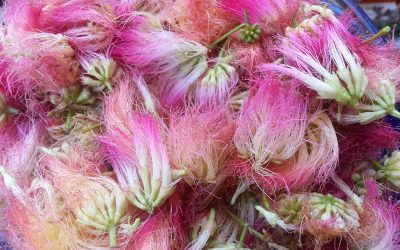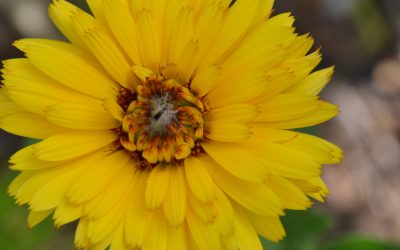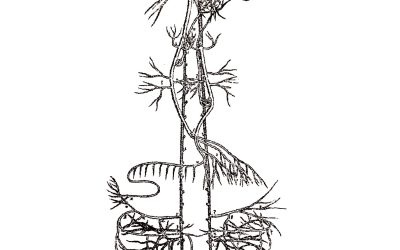Fall Foraging with Prickly Pear and Mesquite
by Dara Saville
 Working with plants provides numerous opportunities to live our lives in harmony with the natural cycles unfolding around us and within us. Just as the end of winter is marked by walking the river and harvesting resinous Cottonwood buds (Populus deltoides wislizenii), the transition to fall reveals itself as I harvest Prickly Pears (Opuntia spp.) in muted late-season light. Prickly Pears are one of the delights of urban foraging as there are many fruiting plants around town here in Albuquerque. In fact, it is easy to find an abundance of Prickly Pears in quiet residential neighborhoods, vacant lots, and alleyways that are well off of the busy main boulevards. Prickly Pear has medicinal uses including positive effects on blood sugar and cholesterol but the best part is baking and beverage making with this magical magenta fruit.
Working with plants provides numerous opportunities to live our lives in harmony with the natural cycles unfolding around us and within us. Just as the end of winter is marked by walking the river and harvesting resinous Cottonwood buds (Populus deltoides wislizenii), the transition to fall reveals itself as I harvest Prickly Pears (Opuntia spp.) in muted late-season light. Prickly Pears are one of the delights of urban foraging as there are many fruiting plants around town here in Albuquerque. In fact, it is easy to find an abundance of Prickly Pears in quiet residential neighborhoods, vacant lots, and alleyways that are well off of the busy main boulevards. Prickly Pear has medicinal uses including positive effects on blood sugar and cholesterol but the best part is baking and beverage making with this magical magenta fruit.
Harvesting and processing these fruits, often referred to as tunas, is easier than you might think. In my area, they begin to ripen in September and continue through the fall and even into the winter. Using tongs, grab onto a fruit, twist, and pull it off gently and place it into your bag or stock pot. There are a number of different methods for dealing with the glochids, or tiny cactus hairs that protect the fruit. Since I usually harvest Prickly Pears from urban environments, I favor the soak and peel method. This involves soaking the fruits in lukewarm water for a half hour or so where most of the glochids will float away. Using the tongs again, remove fruits from the water, slice off the broad flat end, and carefully peel the skin. This experience will vary depending on the fruits. I find that the slightly smaller fruits of Opuntia polya cantha tend to let go of their glochids in the water more freely while the larger fruits of O. englemannii tend to be a little more stubborn. Also some peel more easily than others but often the skin will readily peel back in a manner reminiscent of working with roasted bell peppers. Get it started with a knife and pull pieces back with your fingers, if the fruit is willing. Otherwise, just peel it with your knife. Next, put the peeled fruits in a sieve and push them through with a potato masher and the back side of a large serving spoon. This will collect the seeds and much of the pulp. Depending on the size of the fruits, I frequently get 1 ounce or more of juice per fruit. Not a bad yield and once you get your routine down, this process unfolds rather quickly.
cantha tend to let go of their glochids in the water more freely while the larger fruits of O. englemannii tend to be a little more stubborn. Also some peel more easily than others but often the skin will readily peel back in a manner reminiscent of working with roasted bell peppers. Get it started with a knife and pull pieces back with your fingers, if the fruit is willing. Otherwise, just peel it with your knife. Next, put the peeled fruits in a sieve and push them through with a potato masher and the back side of a large serving spoon. This will collect the seeds and much of the pulp. Depending on the size of the fruits, I frequently get 1 ounce or more of juice per fruit. Not a bad yield and once you get your routine down, this process unfolds rather quickly.
Now that you have all of this Prickly Pear juice, what should you do with it? There are lots of ways to use it and my favorite is the simplest–just drink it. I like to make all sorts  of beverages with Prickly Pear juice including fermented sodas, infused herbal teas, syrup-based cocktails, or dilute it with water as it tastes good on its own. I also freeze it to drink throughout the winter and early spring. Since I like baking and have kids that will eat sweets, I usually end up making some desserts. I have made a number of Prickly Pear treats over the years and my latest recipe is here for you to try out. Regular readers and students will already know that I am in love with my desert home and most everything that comes out of my botanical kitchen reflects this fondness of dryland plants. Mesquite (Prosopis gladulosa torreyana, P. spp.) is the perfect companion for Prickly Pear in landscapes and also in food. It imparts a clear and distinct flavor to foods so try it out for yourself first to see how you like it. Foraging enthusiasts may wish to collect Mesquite pods and process them but without the proper equipment (such as a hammermill), this is a time consuming task and difficult to make a fine floury powder at home. Luckily, mesquite flour is something you can buy and store in your refrigerator for culinary explorations like this. I usually keep it to about 20% of any flour mixture to prevent it from overwhelming the other flavors in whatever recipe I am making.
of beverages with Prickly Pear juice including fermented sodas, infused herbal teas, syrup-based cocktails, or dilute it with water as it tastes good on its own. I also freeze it to drink throughout the winter and early spring. Since I like baking and have kids that will eat sweets, I usually end up making some desserts. I have made a number of Prickly Pear treats over the years and my latest recipe is here for you to try out. Regular readers and students will already know that I am in love with my desert home and most everything that comes out of my botanical kitchen reflects this fondness of dryland plants. Mesquite (Prosopis gladulosa torreyana, P. spp.) is the perfect companion for Prickly Pear in landscapes and also in food. It imparts a clear and distinct flavor to foods so try it out for yourself first to see how you like it. Foraging enthusiasts may wish to collect Mesquite pods and process them but without the proper equipment (such as a hammermill), this is a time consuming task and difficult to make a fine floury powder at home. Luckily, mesquite flour is something you can buy and store in your refrigerator for culinary explorations like this. I usually keep it to about 20% of any flour mixture to prevent it from overwhelming the other flavors in whatever recipe I am making.
Prickly Pear Mesquite Sandwich Cookies with Coconut and Lime
Mesquite Lime Cookies:
- 1/2 cup unsalted butter, softened
- 1/2 cup sugar
- 1 egg
- 2 TBSP fresh lime juice
- 1 1/2 TBSP lime zest
- 1/2 cup almond flour
- 1/2 cup quinoa flour
- 1/4 cup whole wheat flour
- 1/4 cup mesquite flour
- 1/2 tsp baking powder
- 1/4 tsp salt
Prickly Pear Coconut Filling:
- 7.5 ounces coconut manna, softened in a warm water bath
- 1/2 cup milk
- 2 TBSP Prickly Pear juice
- 1 TBSP vanilla
- 1 to 2 TBSP sugar
- pinch of salt
Optional Ganache: I have little interest in desserts without chocolate so this is for my fellow chocolate lovers
- 6 ounces grated or chopped chocolate of your liking
- 3/4 cup heavy cream


Directions:
Making the cookies: Preheat the oven to 375 and line your cookie sheets. Cream the butter and sugar together and then add the egg, lime zest, and lime juice. Scoop drops of this dough onto your cookie sheets, dust them with flour, and flatten them with a broad knife. Bake for about 10 minutes or until the edges start to turn light brown.
Making the filling: Blend all ingredients in a food processor.
Finishing: Once the cookies have cooled, put a spoonful of filling on the backside of a cookie and make a sandwich with a second one. If you wish to add the ganache, warm the cream in a saucepan on medium heat. Put the chocolate in a bowl and pour the heated cream over it. Very gently stir it in a spiral motion without making any bubbles until all is integrated. Wait until this mixture cools (80 degrees or so) and is thick enough to pour it over the cookies without running off.



